So on a recent layover in Anchorage i picked up a mountain bike at Walmart to leave in our crew storage room at the hotel. It certainly makes getting around Anchorage a less time consuming task then walking (although I do enjoy going for a walk around town). So this time in ANC I was looking forward to putting some miles on my bike. Unfortunately rain dominated the weather forecast for Anchorage this weekend, but I grabbed my rain gear and threw it into the suitcase before leaving Hong Kong.
After landing at about 5pm and having dinner, I managed to get some sleep for a few hours despite it being 2pm Hong Kong time. Sleep is always important when you fly long haul, and the easiest way I have been able to fight fatigue, is to just sleep when I’m tired. The trick to to be sure you are not tired when you are reporting for work and about to sit in the seat of a jumbo jet with 400 people on board. This usually means fighting through a little fatigue in the hotel/on a layover to be sure you can get the right amount of sleep when you really need it most. So I wake up at the crack of 2am Anchorage time and do the usual shuffle between watching tv or maybe some movies on Netflix. By the time morning comes, I head to Walmart at 6 am. I am in the market for the biggest gas BBQ I can find, and North America is much cheaper then Hong Kong. I find the one I want, but soon realize I grossly under estimated the size of the box. No way I can handle this thing with my usual load of a suitcase and flight bag. So I decide to put it on hold until the next trip and bring an empty large suitcase. I will unpack the box in the hotel and then repack it into something that rolls. Too bad I didn’t think of that a few days ago. I waste some time wandering around the near empty store and stumble onto a hiking book for the Anchorage Area. Perfect. Between my mountain bike and my hiking shoes, I hope to cover more then a few trails while I have the chance on these trips.
Back to the hotel to find myself tired after some breakfast. It’s raining still, and the local forecast calls for clearing skies in the afternoon. So what better time to get a few more hours sleep.
I wake up at 3pm and eagerly get ready to get on my mountain bike as some blue sky creeps through the hotel window. I read the trail guide for the Tony Knowles Coastal Trail. The trail starts in downtown Anchorage just a few minutes ride away from my hotel and leads all the way to Kincaid Park on the other side of Ted Stevens International Airport (PANC). It’s a 22 mile round trip that is sure to offer some great scenery and maybe a little wild life. The guide cautions for bear and moose encounters and offers the standard “what to do if” so I make sure to read that twice. As the trail leads me by the airport, I make sure to bring my camera’s in hopes of catching a few planes passing over top. The first few miles of the trail take me along the mud flats of Bootlegger Cove. The smell of the pine forrest the trail cuts through is reminiscent of Canada, and certainly nothing like the smells of Hong Kong. It is a crisp 12 degrees in Anchorage today, coupled with the humid air, I can see my breathe for the first time since last winter here, as I puff along the 11 mile trail. The first point of interest is Earthquake Park. In 1964 the largest earthquake in the history of North America (and second largest in worldwide recorded history) struck the Anchorage and surrounding areas. This park used to be home to residents of Anchorage, but after dropping almost 40 feet during the quake, it has since been turned into a park. After a few more miles I realize I am getting close to the airport. I do a quick lap to the end of the trail and then back to a great spotting location at the departure end of runway 33 at PANC. There is a 150 foot bluff just behind me over looking downtown Anchorage and Cook Inlet, a spectacular view for those willing to venture close to the edge.
As I park my bike, drink some water and get my camera’s out of my bag, I take a moment and smile as I realize I flew a 747, 4700 miles across the Pacific, then biked another 11 miles only to sit and watch planes takeoff and land. I used to skip class in University and do the same thing about 12 years ago in Winnipeg. Even while flying at Perimeter in Northern Manitoba, I would often run outside our passenger lounges to see the occasional C-46 or DC-3 takeoff after having dropped off a load of freight for one of the communities. So here I am sitting under the runway when after only a minute or two I hear the roar of four Pratt Whitney R-2800 Super Charged Radial engines lifting the 100,000 pound Douglas Airliner first built in 1946 into the sky. It’s a sound I have always loved. It’s a sound that reminds me of what my grandfather heard every time he pushed forward the throttles of his airliners of the 30’s, 40’s and 50’s before entering the world of turbo props and jetliners. This particular DC-6 belongs to Everts Air Cargo. Everts specializes in cargo delivery to the most remote parts of Alaska (and the world) in some of the most vintage airplanes still flying today. There fleet includes DC-6’s, C-46’s and DC-9’s, among some newer turbo props they use on passenger runs. I have been in touch with the company and will hopefully have a jump seat ride or two arranged for my next visit at the end of the month. As the DC-6 disappears on the horizon, Fed Ex is next in line for departure. There MD-11 lifts off on the Anchorage 6 departure, which calls for a left turn 30 degrees at 600 feet. There is something very pretty about a heavy jet, gently banking in the evening sun as it heads for a part of the planet where English is foreign, the food is different, and the street signs confusing. Simple, but beautiful. The next departure is the one I have been waiting for. Cathay Pacific flight 074 (CX074) departing for Miami Florida. It is the continuation of the same flight I operated the day before from Hong Kong to Anchorage. I manage to get what I think (you can judge for yourself once I have uploaded the photo’s) are some very nice shots of our “Hong Kong Trader” Boeing 747-8F. It is much quieter then the older MD-11 it followed, as the General Electric GENx-67B engines are a much more modern design with a higher bypass ratio, thus reducing the noise.
For me, my evening at the departure end of runway 33 will not get much better then that. So I pack up my gear and head for Lake Hood Seaplane Base. Lake Hood, the world’s busiest seaplane aerodrome, is located immediately adjacent to Anchorage Airport. We share the airspace with the small float planes, as they often pass underneath us while we are on final approach to landing as they position for landing at Lake Hood. I pedal my bike past the two terminal buildings, around the corner to the first of several parking apron’s of Lake Hood. There is also a gravel strip which services the wheel aircraft here so there are plenty of bush planes to see. As I scan the ramp, I can see so many of the planes I have flown in the past. Cessna 152’s, 172’s, and 182’s. Cessna 185’s, there are even a metro or two on the other side of the fence. I stop and try and recount all the different planes I have been checked out on. Here is the list I could come up with:
Cessna 152
Cessna 172 (Land and Seaplane versions)
Cessna 177 RG
Cessna 182
Beechcraft Musketeer
Diamond DA-12
Piper Seneca
Cessna 414
Beechcraft King Air 100
Fairchild Metro’s (SW2, SW3, SW4, SW5)
Beechcraft 99
DeHavilland Dash 8
Diamond DA-42
and of course the Boeing 747 (-400, 400F, 400 BCF, 400 ERF, and -8F)
As I notice the Era Alaska Dash 8-100 takeoff, I realize that almost all of those airplanes I just listed can be found at this airport. I have recently started calling Anchorage “my home away from home, away from home” and this is another reason why!
Now I start pedaling again and head for the largest concentration of seaplanes in the world. I park my bike next to the 3 foot chain link fence and get lucky with my timing. There are two Dehavilland DHC-2 Beavers taxiing for takeoff, as well as a Cessna 185 (an aircraft I have a few hours of seaplane time in) and two Beaver’s on approach to land. Five planes will land and takeoff in the matter of a few minutes. Luck is on my side. I get some pictures and videos of the movements at Lake Hood. There is something romantic about float flying. I got my seaplane rating in the summer of 1999 while I was 16, and flew a total of about 50 hours mostly on a Cessna 172, and a few hours in a Cessna 185F. It is still the most fun I have had flying, even though I did little more then take the plane to a friends cottage and go fishing every other weekend for a summer. I guess the idea of landing anywhere there is water gives the typical seaplane pilot a huge sense of freedom that you just don’t get when you are forced to land on a runway that was built for planes. Lakes, rivers, inlets and the like weren’t built for anything, they are just there for seaplane pilots to use. To fish, to hunt, to canoe or mine, whatever the purpose, they are just there for enjoyment one way or another. As the evening rush at Lake Hood appears to be winding down, I snap one more picture of our 747-400 lifting off in the distance destined for New York. With that, I start pedaling the 11 miles back to the hotel. I really hope I can arrange that jump seat ride with Everts next trip, and I just may have to see about a ride in a seaplane for old times sake. A ride, into wild Alaska.
Fly Safe,
Jeremy
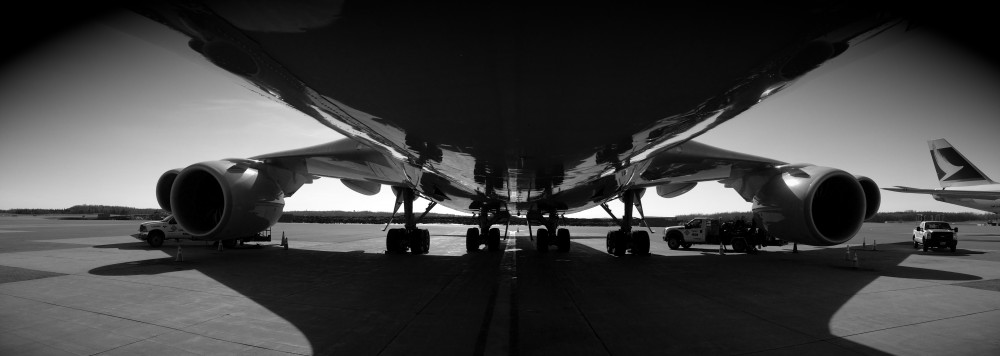
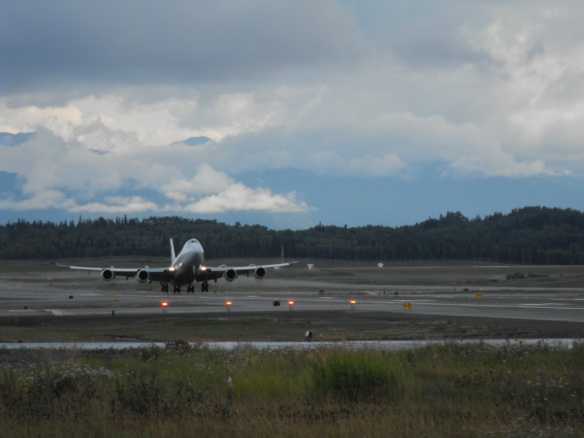
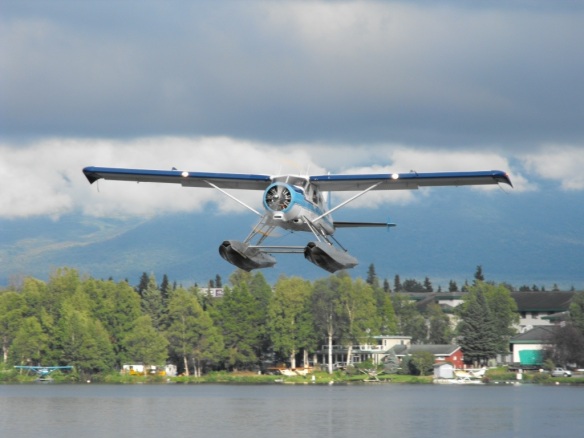
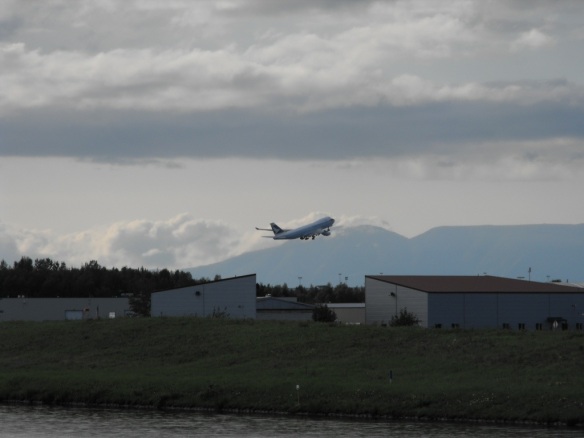
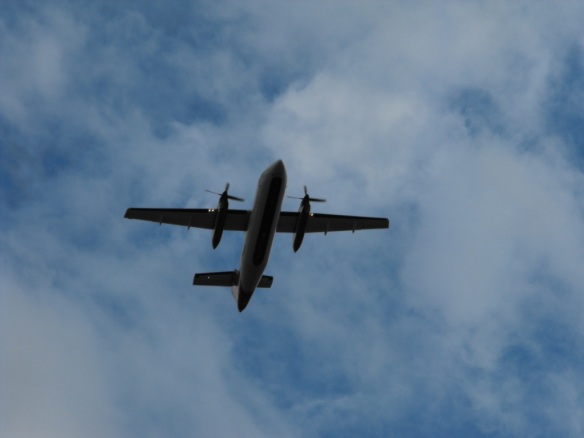
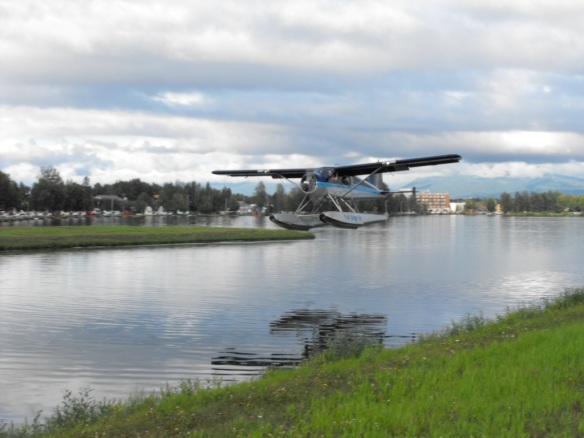
Excellent!
This was great! Thank you! 🙂
I really enjoyed your post. Thank you so much. LSP
Great writing Jeremy. I hope to be joining you on the CX line here in a few months time! Looking forward to more posts.
Thanks Scott! We are looking forward to having you here! More posts coming!